DEFINING THE POND
Choosing its area and shape
If you are going to use seining for harvesting, which is often practised in freshwater prawn farming because of the necessity to cull out larger animals (and sometimes to separate females from males, when they have different values) before the final harvest, rectangular ponds are the most suitable shape.
The maximum width for this type of management should not be wider than the space through which a seine can be conveniently drawn from one end of the pond to the other by manual labour. A convenient width is 30 m. In practice, of course, wider ponds can also be seined but not so efficiently as narrow ones. The length of the pond depends partly on the topography of the site and partly on the pond size and farm layout chosen. It is best to standardize the width of ponds; otherwise a range of different seine nets will be required for harvesting.
The most easily managed pond sizes range between 0.2 ha and 1.6 ha, with most farms having ponds around 0.2-0.6 ha. If kept to a 30 m width, a 0.6 ha pond will be 200 m long. Narrow ponds should be oriented so that the prevailing wind (which enhances the dissolved oxygen content of the water) blows down the long axis towards the drain end, to lessen the area of the pond bank subject to wave erosion.
Large ponds are normally wider than 30 m and often drained for harvesting. If the total harvest is going to be taken at one time (batch management), the size of the pond should be influenced by the maximum weight of prawns that the market will accept at one time without price deflation. For example, if a quantity greater than 300 kg of freshwater prawns would swamp your market and reduce prices it would be pointless to have a drainable pond greater than 0.15 ha in area (assuming a productivity of 2 mt/ha/crop).
Information on pond construction is introduced in Muir and Lombardi (2000); details of construction techniques are provided in FAO (1995).
Choosing its depth
The average depth of water in freshwater prawn ponds in tropical areas should be about 0.9 m, with a minimum of 0.75 m and a maximum of 1.2 m. Deeper ponds (an average of 1.2-1.4 m) are used in colder areas to maintain more stable water temperatures. However, deeper ponds are difficult to manage. Even if you have ponds of the recommended average depth you may have to drain or pump out part of the water to facilitate seining operations at the deep end. In the cool season, the temperature of the water at the bottom of deep ponds may become low enough the reduce feed consumption by the prawns. On the other hand, the water in shallower ponds may become too hot for the prawns in the hot season and the water may be quite clear, exposing the prawns to greater predation. Shallow ponds also tend to support the growth of rooted aquatic plants and are not recommended.
The bottom of the pond must be smooth (Figure 44). There must be no projecting rocks or tree stumps in it; these would prevent efficient seining and damage nets. The pond bottom must slope gradually and smoothly from the water intake end towards the drain end so that, when drained, pockets of undrainable water in which prawns become stranded and die do not occur. A slope of 1:500 (0.2%) is suggested for ponds 0.4 ha or more in area and 1:200 (0.5%) for smaller ponds towards the outlet, where drain harvesting occurs. This is equivalent to 2-5 cm per 10 m length. Thus (for example), in a pond which is 100 m long with an average water depth of 0.9 m (90 cm) and a slope of 0.5%, the water would be 65 cm deep at the intake end and 115 cm deep at the outlet end.
FIGURE44
The bottoms of grow-out and nursery ponds need to be sloped towards the drainage point and to be smooth; this increases the efficiency of both drain-harvesting and seine-harvesting
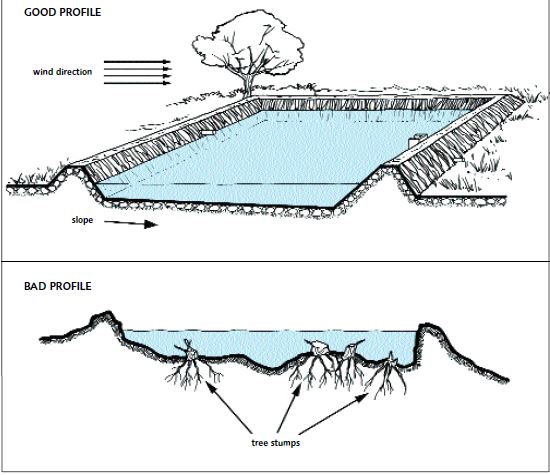
SOURCE: EMANUELA D’ANTONI
Constructing the pond banks
The banks of the ponds (sometimes referred to as embankments or bunds) must be high enough to provide a freeboard of 30-60 cm above the highest water level expected in the pond. Thus, in a pond with a water depth of 65 cm at the shallow end and 115 cm at the deep end, the total bank height must be a minimum of 0.95 m (inlet end) to 1.45 m (outlet) high. The pond banks must also be high enough to protect the pond from exterior flooding.
Proper compaction must be employed, both in the construction of the pond banks and the treatment of the bottom of the ponds to maximize water retention. Where the retention characteristics of the soil on the site are not good, a core of impervious material brought from outside the site must be provided during pond bank construction. This core should extend below the level of the bottom of the pond (Figure 45).
For ease of management the internal slope of the pond bank should be 3:1 but it may need to be as high as 4:1 in sandy areas to minimize erosion (and the consequential need for repairs). In highly stable soils the inner slope should not be less than 2.5:1 (Figure 46).
Very small ponds with almost vertical sides may be constructed for artisanal purposes in floodplains having very sticky and impermeable clay soils. Fruit trees or other crops may be planted on the pond banks. Sometimes attempts are made to protect the banks from excessive erosion by stakes (for example). Having vertical or near-vertical pond banks almost certainly leads to rapid erosion problems; Figure 47 illustrates the result. This
FIGURE45
When you construct ponds in areas where the soil structure is less suitable, the banks will leak less if you bring clay from another site and use it to make an inner impervious core
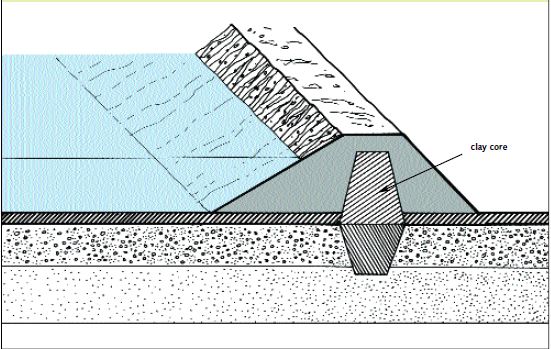
SOURCE: EMANUELA D’ANTONI
FIGURE46
Pond banks should have the proper angle of slope if you want to minimize erosion and cut down the costs of maintenance
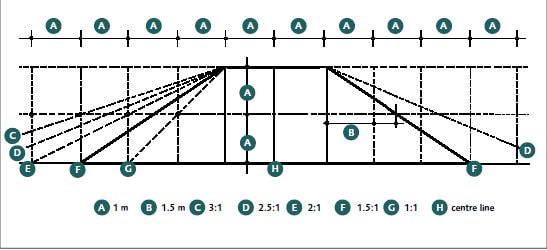
SOURCE: EMANUELA D’ANTONI
means that a lot of maintenance will be required and they are certainly not recommended for larger commercial-scale farms.
The external pond bank slope should preferably be at least 2.5:1 and never less than 1.5:1, even for highly stable soils. Properly constructed pond banks are more expensive and use more land but failure to build them correctly may result in severe erosion (Figure 47).
After construction, you should plant the banks with fast growing grass (e.g. Phyla nodifera), kudzu (a woody vine) or taro (dasheen), to help prevent erosion. Figure 48 illustrates pond banks overlaid with turf. Figure 49 shows banks planted with grass, banana and coconut trees. The planting of large trees or plants with extensive root systems on top of the pond banks may break up the pond bank and cause leakage, so caution is recommended.
Plants such as banana, palm trees and papaya are acceptable and palms form wind breaks.
Figure 47
The bank of this freshwater prawn pond is being eroded because its slope is too steep (Hawaii)
Figure 48
The banks of these ponds have had grass turfs laid on them (Brazil)
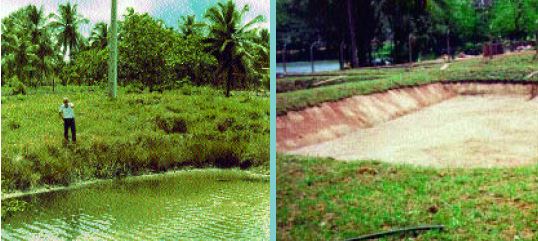
SOURCE: SPENCER MALECHA SOURCE: WAGNER VALENTI
Figure 49
Pond bank planted with coconut, grass, and banana; besides stabilising the bank this is a form of integrated farming (Thailand)
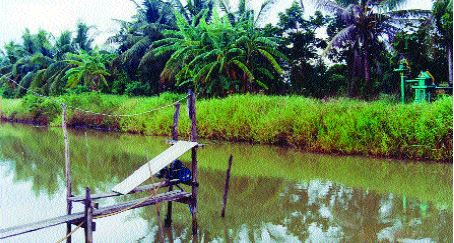
SOURCE: HASSANAI KONGKEO
The tops of the pond banks between ponds should be a minimum of 1 m wide to allow workers to walk round the ponds carrying feed and harvesting gear. Narrow pond banks with almost sheer sides are sometimes staked to prevent collapse but they need constant maintenance particularly if the site is sloping and the water level in adjacent ponds is different.
Make sure that you have a pond bank width of at least 2-3 m at one side of the pond (usually the drain end or where harvest nets are to be beached) so that trucks can be brought to the pond side for delivering PL and feed and picking up harvested prawns, especially live prawns. On larger farms, particularly where mechanical broadcasting of feed is employed, you must provide a wide pond bank top (usually 3.5-4.0 m) on one of the long sides of the pond as well as at one end.
Information on pond bank construction is introduced in Muir and Lombardi (2000) and construction details are provided in FAO (1995).